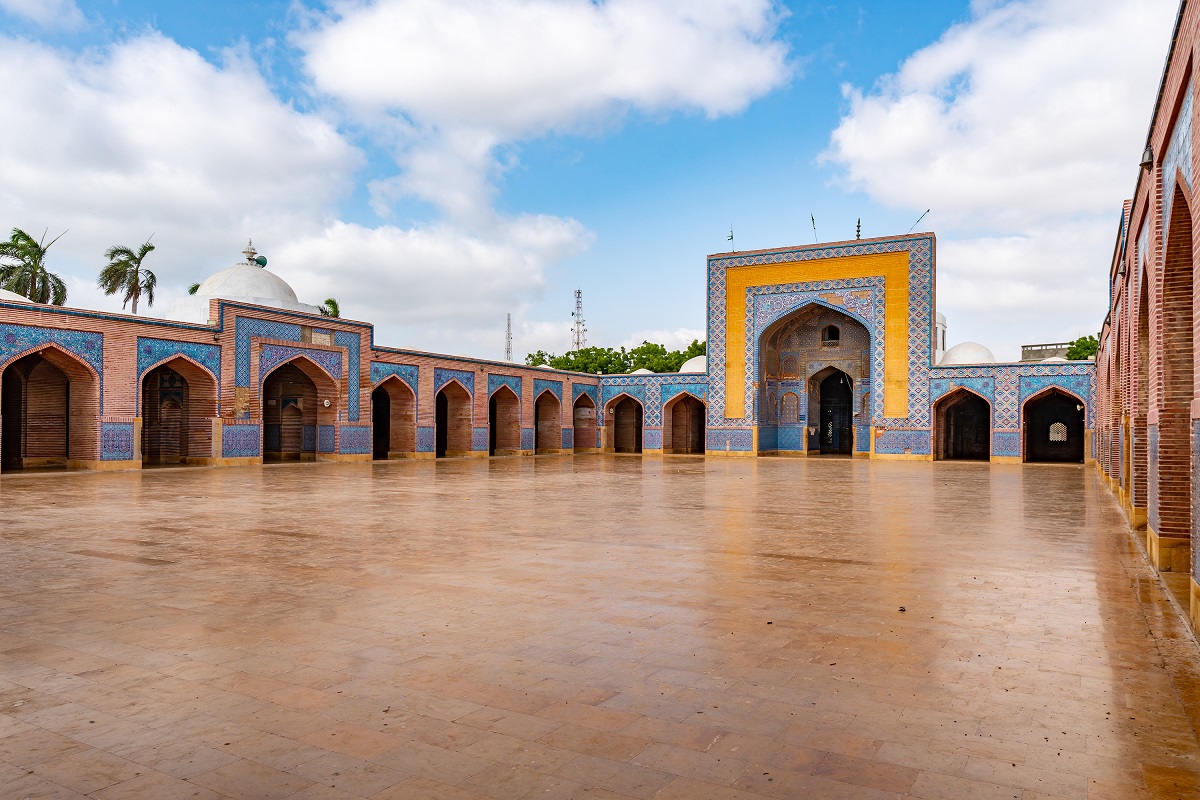 The Shah Jahan Mosque, in any case, called the Jamia Masjid of Thatta, is a seventeenth-century assembly that fills in as the central synagogue for the megacity of Thatta, in the Pakistani district of Sindh. The synagogue was worked during the standard of Mughal sovereign Shah Jahan, who gave it to the megacity as identification of appreciation. The synagogue is admired to have the most unpredictable show of tile work in South Asia and is furthermore unmistakable for its numerical square work-a a breathing new life into the part that's astonishing for Mughal- period mosques.
The Shah Jahan Mosque, in any case, called the Jamia Masjid of Thatta, is a seventeenth-century assembly that fills in as the central synagogue for the megacity of Thatta, in the Pakistani district of Sindh. The synagogue was worked during the standard of Mughal sovereign Shah Jahan, who gave it to the megacity as identification of appreciation. The synagogue is admired to have the most unpredictable show of tile work in South Asia and is furthermore unmistakable for its numerical square work-a a breathing new life into the part that's astonishing for Mughal- period mosques.The locality of Shah Jahan Mosque
The mosque is situated on the eastern edge of Thatta, the Shah Jahan Mosque is organized close to the National Highway (N5) at its intersection point with Sujawal-Thatta Road. It's found around 100 kilometers from Karachi. An external nursery and a wellspring lead the way to the mosque's essential section.
Chronicle Of The Synagogue And Its Extant Status
The Shah Jahan Mosque goes probably the Jamia Mosque for Thatta. The mosque's enhancement began in 1644 constrained by the Mughal Emperor Shah Jahan while he stayed in Thatta directly following getting away from his palatial home after an inquiry with his father, Emperor Jahangir. The synagogue was worked throughout three years and was officially opened for everybody in 1647. Destiny has grinned down from paradise a present for people of Thatta to offer thanks toward them for their kind disposition when they had opened their homes and their hearts to have Shah Jahan during his succinct stay here. The synagogue has been on the theoretical once-over of UNESCO World Heritage emplacements starting around 1993 anyway has not officially been articulated as a secured achievement.
Refinement of the Shah Jahan Mosque In Thatta
The Shah Jahan Mosque is one of just a modest bunch of extraordinary Mughal- time mosques in Pakistan that depict an advancement style that's savvy of that period. In any case, this particular synagogue was affected by Mughal configuration just as by Sindhi, Persian, Timurid, and Indian styles of advancement that have made it a dais-out wonder. Brand name red Places have been used to develop the synagogue, yet it's the tile work and numerical models that redesign its greatness. To be sure, indeed without the usage of frescoes, which are all effects considered found in most Mughal- period advancements, the dividers, vaults, bends, and entrances all have an innate stunner on account of the planned tile work and the calligraphy scratched into them in Persian and Arabic. The mosque parades the most curves in any plan in Pakistan, with the full scale moving someplace in the scope of 93 and 100, while the power plaque communicates the development to be the last choice. Worked when present-day advancement was non-existent, the synagogue and its openings are a way that grants air to go through the entire plan, ensuring that people who come for their requests do not feel suffocated or tedious.
What's more, within the synagogue is certain such a way that the petitions can be heard from the Mihrab of the mosque to the contrary completion of the plan with the use of resonations, rather than using any voice improving ways. A central balcony prompts the rule request hall, with its cutoff points checked using calculated entries. The sections open up into the yard as 33 bends, while four entrances moreover lead outward from the ways, one going up against all of four headings. In like manner, the synagogue has four outside and one inside entrance, inciting the essential appeal hall. The essential appeal entryway is the jewel in the crown, with an outside built using tones of blue, turquoise, and fuchsia tiles. Within curve utilizes analogous tones close by hints of red, white, and yellow to address the superb skies above. A couple of the more humble vaults and bends around the porch moreover show dazzling numerical instances of brickwork which set this synagogue beside some other of the time. The brickwork is clashing with Mughal- period designing yet is smart of the blend of improvement styles that this mosque is by and large known for.
Extraordinary Features of the Shah Jahan Mosque, Thatta
- No frescoes
- No minarets
- Further than 90 curves
- Entreating limit regarding individuals
- Ordinary ventilation all through within
- Improvement was done using 9 lakh rupees of the time
- Petitions resonation all through the mosque without the usage of advancement
Thusly Shah Jahan left behind a marvelous custom of designing milestones for the future Mughals and the world to appreciate. The significance in compositional craftsmanship achieved during the Shah Jahan period has gained him the title of architect ruler. He was the best sponsor of Mughal design. Shockingly, there are breaks in the dividers of this beautiful piece of workmanship and clear marks of developing in the structure of the design suggesting extensive stretches of dismissal by the trained professionals.






Comments (0)
Leave a comment